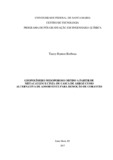| dc.creator | Barbosa, Tuany Ramos | |
| dc.date.accessioned | 2018-10-16T22:03:16Z | |
| dc.date.available | 2018-10-16T22:03:16Z | |
| dc.date.issued | 2017-08-11 | |
| dc.identifier.uri | http://repositorio.ufsm.br/handle/1/14572 | |
| dc.description.abstract | The industrial activity has contributed greatly to a significant increase in the concentrations of dyes in water, representing an important source of contamination of the water bodies, especially when we consider that such ions can be disseminated through the food chain. Due to these environmental implications, new processes of removal and / or degradation of these compounds in textile effluents have been tested, among them the adsorption. The adsorption process is a potentially versatile, affordable and economical alternative for the treatment of various types of effluents, including those of the textile industries. The objective of this work was a synthesis, characterization of a new geopolymer and the evaluation of the removal capacity of the methyl violet dye 10B. The geopolymer was synthesized from metacaulim, being a clay mineral used in several industrial sectors and, due to the high availability in the earth's crust, chemical modifications were made to obtain different structures of the material, seeking to extend its use, together with the rice husk , With (MGP) and without soybean oil (GP) as the modeling agent. GP, MGP and the precursors were characterized and used to remove methyl violet dye 10B (MV10B) from aqueous solutions. The samples were characterized by X-ray diffractometry (XRD), Spectroscopy in the Infrared Region with Fourier Transform (FTIR). MGP showed much higher characteristics and adsorption potential in relation to GP and precursors. Adsorption studies have shown that MGP is an efficient adsorbent. The equilibrium was reached within 120 min and the maximum adsorption capacity was 276.9 mg / g. MGP is a new alternative adsorber that presented higher porosity, having better results with the methyl violet dye 10B, representing advantages as high efficiency, fast kinetics and high adsorption capacity. | eng |
| dc.language | por | por |
| dc.publisher | Universidade Federal de Santa Maria | por |
| dc.rights | Attribution-NonCommercial-NoDerivatives 4.0 International | * |
| dc.rights.uri | http://creativecommons.org/licenses/by-nc-nd/4.0/ | * |
| dc.subject | Adsorção | por |
| dc.subject | Remoção de contaminantes | por |
| dc.subject | Efluentes têxteis | por |
| dc.subject | Geopolímero | por |
| dc.subject | Adsorption | eng |
| dc.subject | Dye removal | eng |
| dc.subject | Microwave | eng |
| dc.subject | Peanut shell | eng |
| dc.subject | Geopolymer | eng |
| dc.title | Geopolímero mesoporoso obtido a partir de metacaulim e cinza de casca de arroz como alternativa de adsorvente para remoção de corantes | por |
| dc.type | Dissertação | por |
| dc.description.resumo | A atividade industrial tem contribuído muito para um aumento significativo nas concentrações de corantes em águas, representando uma importante fonte de contaminação dos corpos hídricos, principalmente quando consideramos que tais íons podem ser disseminados via cadeia alimentar. Devido a estas implicações ambientais, novos processos de remoção e/ou degradação destes compostos em efluentes têxteis têm sido testados, dentre eles a adsorção. O processo de adsorção é uma alternativa potencialmente versátil, acessível e econômica para o tratamento de diversos tipos de efluentes, inclusive os das indústrias têxteis. Objetivou-se neste trabalho uma síntese, caracterização de um novo geopolímero e a avaliação da capacidade de remoção do corante 10B de violeta de metilo. O geopolímero foi sintetizado a partir de metacaulim, sendo um argilomineral empregado em diversos setores industriais e, em decorrência da elevada disponibilidades na crosta terrestre são realizadas modificações químicas para a obtenção de diferentes estruturas do material buscando ampliar sua utilização, juntamente com a casca de arroz, com óleo (MGP) e sem óleo de soja (GP) como materiais sintetizados. O GP, o MGP e os precursores foram caracterizados e utilizados para remover o corante 10B de violeta de metilo (MV10B) a partir de soluções aquosas. As amostras foram caracterizadas por Difratometria de Raios X (DRX), Espectroscopia na Região do Infravermelho com Transformada de Fourier (FTIR). O MGP apresentou características bem superiores e potencial de adsorção em relação ao GP e aos precursores. Estudos de adsorção revelaram que o MGP é um adsorvente eficiente. O equilíbrio foi atingido dentro de 120 min e a capacidade máxima de adsorção foi de 276,9 mg/g. O MGP é um novo adsorvedor alternativo que apresentou maior porosidade, tendo melhor resultado com o corante 10B de violeta de metilo, representando como vantagens a alta eficiência, cinética rápida e alta capacidade de adsorção. | por |
| dc.contributor.advisor1 | Jahn, Sérgio Luiz | |
| dc.contributor.advisor1Lattes | http://lattes.cnpq.br/7735147410610776 | por |
| dc.contributor.referee1 | Foletto, Edson Luiz | |
| dc.contributor.referee1Lattes | http://lattes.cnpq.br/6550340290019699 | por |
| dc.contributor.referee2 | Salazar, Rodrigo Fernando dos Santos | |
| dc.contributor.referee2Lattes | http://lattes.cnpq.br/9370462066771109 | por |
| dc.creator.Lattes | http://lattes.cnpq.br/6293978036802106 | por |
| dc.publisher.country | Brasil | por |
| dc.publisher.department | Engenharia Química | por |
| dc.publisher.initials | UFSM | por |
| dc.publisher.program | Programa de Pós-Graduação em Engenharia Química | por |
| dc.subject.cnpq | CNPQ::ENGENHARIAS::ENGENHARIA QUIMICA | por |
| dc.publisher.unidade | Centro de Tecnologia | por |



